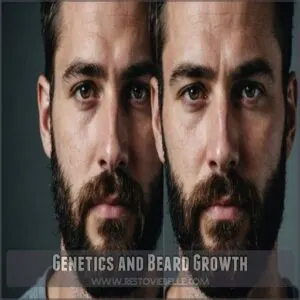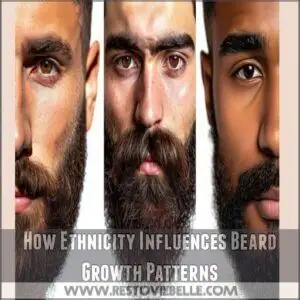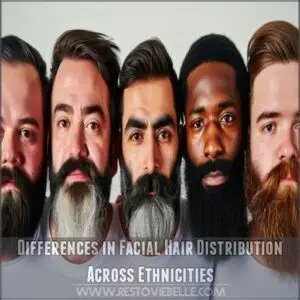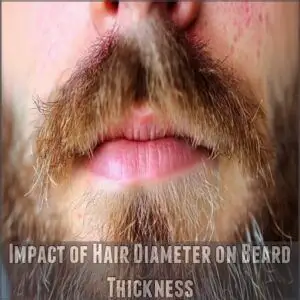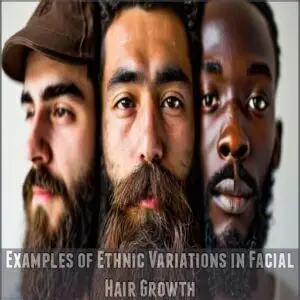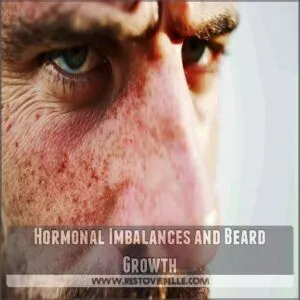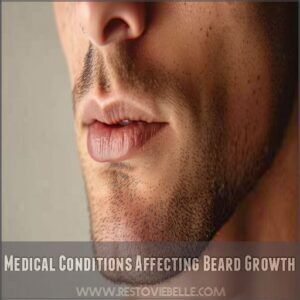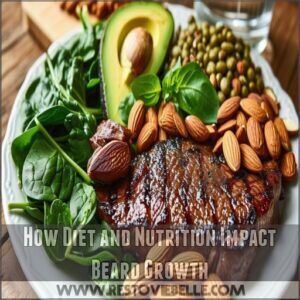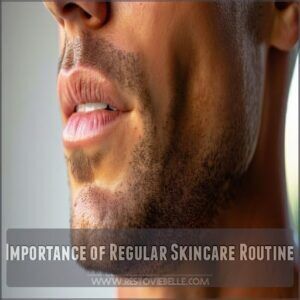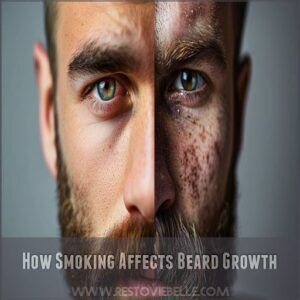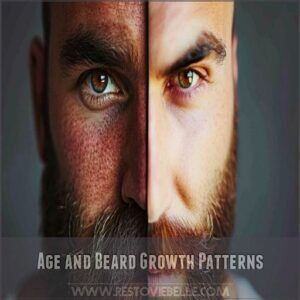This site is supported by our readers. We may earn a commission, at no cost to you, if you purchase through links.
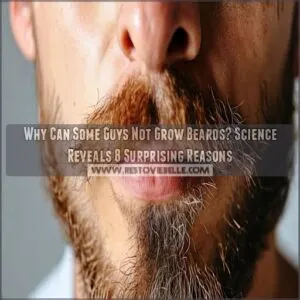
Your genes play the biggest role in determining your facial hair growth potential through hormone sensitivity and hair follicle patterns.
Ethnicity also influences beard thickness and distribution, with some groups naturally having denser facial hair than others.
Your age matters too, since beard growth often peaks in your late 20s.
Medical conditions like alopecia areata or hormonal imbalances can impact growth as well.
The good news? Understanding the science behind your facial hair opens up effective ways to work with what you’ve got.
Table Of Contents
- Key Takeaways
- Genetics and Beard Growth
- Why Can’t Some Guys Grow Beards
- Ethnicity and Facial Hair Growth
- Hormonal Imbalances and Beard Growth
- Alopecia Areata and Beard Growth
- Medical Conditions Affecting Beard Growth
- Lifestyle Factors Affecting Beard Growth
- Age and Beard Growth Patterns
- Facial Hair Restoration Options
- Frequently Asked Questions (FAQs)
- Why can’t a man grow a beard?
- Does castor oil help with the growth of a beard?
- Why do some men give up on their beards?
- Do beards help men grow a fulsome beard?
- Can men with unfavorable genetic characteristics grow a thick beard?
- Can a man grow a full beard?
- Can some men not grow beards at all?
- What ethnicity can’t grow facial hair?
- How do you know if you can’t grow a beard?
- Why would a man’s beard stop growing?
- Can diet supplements help stimulate facial hair growth?
- Do facial exercises increase beard thickness naturally?
- How do stress levels affect beard patches?
- Why do some beards grow in different colors?
- Does frequent shaving make facial hair grow faster?
- Conclusion
Key Takeaways
- Your genes are the main factor determining beard growth – they control how sensitive your hair follicles are to testosterone and set your facial hair growth patterns.
- Your ethnicity influences beard characteristics – Mediterranean and Middle Eastern men typically have denser facial hair than Asian or Native American men due to genetic variations.
- Your hormones, particularly testosterone and DHT, directly impact beard growth – low levels or sensitivity issues can result in patchy or thin facial hair.
- Your age affects beard development, and for some, genetics may also play a role, as issues like alopecia barbae, an autoimmune disease that targets beard hair follicles learn more about alopecia barbae, can impact growth. While facial hair starts growing during puberty, you won’t see your beard’s full potential until your late 20s or early 30s.
Genetics and Beard Growth
Your beard’s thickness and growth pattern come straight from your family tree, just like your eye color or height.
DNA controls how sensitive your hair follicles are to testosterone.
If you’ve noticed patches or thin spots in your facial hair, you can blame your DNA since it controls how sensitive your hair follicles are to testosterone.
Role of Androgens in Beard Growth
Ever wondered why some guys sprout beards like magic while others struggle? It all comes down to androgens – the hormones driving your facial hair growth. These powerful compounds work like keys triggering your beard’s potential.
Your body’s relationship with androgens affects beard growth through:
- Hormone sensitivity in facial hair follicles
- Natural testosterone production levels
- Androgen receptor density
- Growth cycle timing
- Cell response to hormonal signals
Impact of 5-Alpha Reductase on DHT
Your beard’s thickness hinges on a key enzyme called 5-alpha reductase, which transforms testosterone into DHT (dihydrotestosterone).
Think of it as your beard’s growth accelerator – when it’s working well, you’ll likely sport fuller facial hair.
But if your body produces less of this enzyme, you might notice patches or thinner growth, similar to how a garden struggles without proper fertilizer.
Genetic Influence on Hair Follicle Sensitivity
Beyond DHT production, your genes control how sensitive hair follicles are to hormones, with some men inheriting a higher tendency for thicker facial hair growth.
Think of follicles like tiny radio receivers – some guys’ are tuned to pick up strong signals, while others might need more boost to respond.
These genetic variations explain why two men with identical testosterone levels can have completely different beard growth patterns. It’s like having different antenna strengths for your facial hair.
Why Can’t Some Guys Grow Beards
A patchy or non-existent beard isn’t just about genetics – several factors determine your facial hair growth.
While about 24% of American men can’t grow substantial facial hair, understanding why helps put things in perspective.
Think of your hair follicles like tiny gardens – they need the right conditions to thrive.
Hormones, particularly testosterone and its converted form DHT, act like fertilizer for these follicles.
But even with normal hormone levels, your follicles mightn’t be sensitive enough to respond.
Some guys notice their beards fill in gradually until age 30, while others may face challenges like alopecia areata, which causes patchy growth.
Stress, poor nutrition, and certain medications can also impact beard development.
The good news? Low testosterone levels, often a result of hormonal imbalances, can hinder beard growth, but beard transplants and other treatments like testosterone replacement therapy. Modern solutions like beard transplants offer hope for those seeking fuller facial hair.
Ethnicity and Facial Hair Growth
You might notice that your beard growth pattern is different from your friends of other ethnic backgrounds because genetics plays a key role in determining facial hair characteristics.
Your ethnicity can influence everything from your beard’s thickness to its distribution pattern which explains why Mediterranean men often grow thicker beards than their Asian or Native American counterparts.
How Ethnicity Influences Beard Growth Patterns
Genetics play a fascinating role in how beards grow across different ethnic groups.
Men from Mediterranean and Middle Eastern backgrounds often sport thicker, fuller beards thanks to their genetic makeup.
Here’s what research shows about ethnic influences on beard growth:
- Androgen receptor sensitivity varies by ethnic background
- Mediterranean men typically have higher facial hair density
- Native Americans and Asian men often have lighter beard growth
- Nordic populations show varied beard thickness patterns
- African men frequently have tightly coiled, dense facial hair
Differences in Facial Hair Distribution Across Ethnicities
Facial hair patterns tell a fascinating story of human diversity.
Native Americans and East Asians typically experience lighter facial hair growth, while Mediterranean and Middle Eastern men often sport fuller beards.
African men frequently develop thick, coiled facial hair that grows in unique patterns.
Northern Europeans tend to have lighter, sometimes patchier coverage, especially in the cheek areas.
These differences shape the distinct beard characteristics you’ll notice across populations.
Impact of Hair Diameter on Beard Thickness
While your hair’s thickness plays a starring role in how full your beard appears, it’s actually the diameter of each strand that makes the biggest difference.
Your beard might look patchy even with lots of hair if the strands are ultra-fine.
You might be wondering if there are any solutions to this, and luckily, there are!
You can try using a beard growth oil to help boost hair growth and possibly even increase the diameter of your hair strands.
Here’s what affects your hair diameter:
- Follicle size and shape
- Genetic predisposition to hair thickness
- Hormonal influence on follicle development
The thicker each hair strand, the fuller and more substantial your beard will appear.
Examples of Ethnic Variations in Facial Hair Growth
Let’s talk about how your family tree shapes your beard game.
You’ll notice striking differences in facial hair patterns across ethnic groups – it’s like nature’s own signature style.
It’s worth noting that the unique characteristics of Asian hair, such as its straight and fine texture, also apply to their facial hair, often resulting in a lighter and more compact hair structure.
| Ethnic Group | Typical Beard Characteristics |
|---|---|
| Mediterranean | Dense, full coverage, early growth |
| East Asian | Lighter, focused on chin/mustache |
| African | Coarse, curved hair pattern |
| Nordic | Thick, often reddish tones |
| Native American | Variable coverage, later onset |
These patterns aren’t just random – they’re your genetic heritage showing up on your face.
Hormonal Imbalances and Beard Growth
If you’ve struggled to grow a full beard you might be dealing with a hormonal imbalance that’s affecting your facial hair growth.
Your body needs the right balance of testosterone and other hormones to transform those tiny facial hairs into the thick manly beard you’re hoping for.
Role of Testosterone in Facial Hair Growth
Testosterone works like a master key, boosting your beard’s true potential. When this hormone enters your system, it transforms into dihydrotestosterone (DHT), which tells your facial hair follicles to grow thicker and darker.
- Your beard’s growth pattern is as unique as your fingerprint
- Each follicle responds differently to testosterone‘s signals
- Some guys naturally have more sensitive androgen receptors
- Your body’s DHT production rate plays a starring role
Think of testosterone as the director of your facial hair show – it gives the cues, but your genetics determine how well the actors (your follicles) follow direction.
Impact of Low Testosterone on Beard Growth
Low testosterone can put the brakes on your beard growth, but understanding the numbers helps you take control.
Here’s what you need to know about testosterone levels and facial hair:
| Testosterone Level | Impact on Beard | Solutions |
|---|---|---|
| Below 300 ng/dL | Sparse growth | TRT |
| 300-500 ng/dL | Patchy beard | Diet/Exercise |
| Above 500 ng/dL | Normal growth | Maintenance |
If you’re struggling with beard growth, getting your T-levels checked could reveal the answer you’ve been looking for.
How Hormonal Imbalances Affect Facial Hair Growth
Beyond testosterone levels, various hormonal imbalances can throw your beard growth into chaos.
Your body’s endocrine system works like a finely tuned orchestra – when one instrument’s off, the whole performance suffers.
Thyroid disorders, elevated cortisol from stress, and certain medications can all disrupt the delicate hormonal balance needed for healthy beard growth.
Even your sleep patterns play a role in keeping those hormones in check.
Alopecia Areata and Beard Growth
If you’re noticing round patches of missing hair in your beard, you may be dealing with alopecia areata, a condition where your immune system mistakenly attacks your hair follicles.
You’ll want to see a doctor for proper diagnosis since this autoimmune condition can be treated with various options including creams and medications.
Symptoms and Treatment Options for Alopecia Areata
Alopecia areata starts as a mysterious patchwork in your beard – small, round spots where hair suddenly stops growing.
You might notice redness or tingling before the patches appear.
You can also explore online resources that offer products for Alopecia areata treatment Alopecia areata products.
The good news? Treatment options pack a punch.
From topical corticosteroids and minoxidil to platelet-rich plasma therapy, you’ve got choices.
A dermatologist can map out your best strategy, often starting with steroid injections that show promising success rates.
How Alopecia Areata Affects Facial Hair Growth
Understanding how alopecia areata impacts your beard growth isn’t complex – it’s like a game of hide and seek with your facial hair.
The condition targets random patches in your beard, causing the hair to suddenly fall out.
You’ll notice circular, smooth patches where your beard used to be.
While it can feel frustrating, remember that these patches often grow back, though the timing varies.
Medical Conditions Affecting Beard Growth
If you’re struggling to grow a full beard, you might’ve an underlying medical condition that’s affecting your facial hair growth.
You’ll want to talk to your doctor about conditions like alopecia areata or thyroid issues that could be stopping those whiskers from sprouting.
Other Medical Conditions That May Affect Beard Growth
Several medical conditions can throw a wrench in your beard growth plans. If genetics and hormones, such as testosterone levels in ethnicities, play a significant role in determining facial hair growth patterns, the root cause might be lurking beneath the surface.
- Thyroid disorders can slow down hair growth across your body
- Certain medications like chemotherapy drugs affect follicle function
- Skin conditions like eczema and psoriasis damage hair follicles
- Hormonal disorders impact testosterone production
- Vitamin deficiencies, especially biotin and vitamin D, weaken hair growth
Importance of Consulting a Doctor for Diagnosis
When your beard isn’t growing as expected, booking an appointment with your doctor is the first step to uncovering why.
Here’s a quick guide to help you understand when to seek medical advice:
| Symptom | When to Act | What to Expect |
|---|---|---|
| Patchy Growth | After 6 months | Physical exam, history |
| Sudden Loss | Within 2 weeks | Biopsy possible |
| Color Changes | Right away | Hormone testing |
| Itching/Pain | Within days | Skin analysis |
| No Growth | By age 25 | Blood work |
Lifestyle Factors Affecting Beard Growth
You won’t believe how much your daily habits can affect your beard’s growth from proper nutrition to skincare routines and even smoking.
If you’re struggling to grow a full beard you’ll want to check these lifestyle factors that might be holding you back.
How Diet and Nutrition Impact Beard Growth
Your beard’s health starts in your kitchen.
Like a garden needs rich soil, your facial hair needs proper nutrition to thrive.
Research shows that specific nutrients directly impact beard growth and thickness.
Here’s what science says you need:
- Biotin-rich foods boost hair follicle strength
- Zinc supports healthy testosterone levels
- Protein provides building blocks for new hair growth
Skip the fad diets – they often lack these essential nutrients.
Importance of Regular Skincare Routine
A solid skincare game makes all the difference in your beard’s potential.
Just like a garden needs good soil, your facial hair thrives on healthy skin underneath.
Using a beard oil for growth, such as those found in beard growth products, can also help to nourish and condition your beard.
| Skincare Step | Benefits for Beard Growth |
|---|---|
| Gentle exfoliation | Removes dead skin cells, prevents ingrown hairs |
| Daily moisturizing | Reduces itchiness, promotes healthy follicles |
| SPF protection | Prevents follicle damage from UV rays |
| Deep cleansing | Controls oil, reduces beard dandruff |
This consistent care routine keeps those follicles happy and functioning at their best.
How Smoking Affects Beard Growth
Taking care of your skin sets the stage for healthy beard growth, but smoking can throw a wrench in your plans. Research shows tobacco’s nasty habits hit your facial hair hard:
- Nicotine shrinks blood vessels, starving hair follicles of nutrients
- Carbon monoxide blocks oxygen from reaching your beard roots
- Smoking ages skin cells faster, weakening follicle strength
- Chemical toxins damage DNA in hair-producing cells
Think of it like trying to grow a garden in polluted soil – it just won’t thrive.
Age and Beard Growth Patterns
If you’re wondering why your beard isn’t growing like your dad’s yet, you’ll be relieved to know that facial hair continues developing well into your late twenties.
You’ll likely notice changes in your beard’s thickness and coverage as your testosterone levels naturally shift with age, which means there’s still hope for filling in those patchy spots.
How Age Affects Facial Hair Coverage
The journey of facial hair growth starts during puberty, typically between ages 12-16.
Most guys notice their first beard hairs around 13, but full coverage usually develops between 25-35.
Think of it like a garden – some patches fill in earlier, while others take their sweet time.
By 30, you’ll generally see your beard’s final form in terms of coverage and density.
Changes in Testosterone Levels With Age
Testosterone levels gradually decline as you age, typically dipping about 1% each year after 30. Think of it like a slowly dimming light – it’s natural but can affect your facial hair. Here’s what happens to your hormones over time:
- Peak testosterone occurs in your early 20s
- Natural decline begins around age 30
- Lifestyle factors can speed up or slow down this process
- Diet and exercise help maintain healthy levels
Impact of Age on Beard Growth Rate
Your beard growth rate shifts gears throughout different life stages.
During puberty, you’ll notice the first signs around age 13-15, but don’t expect a full beard right away.
This is largely influenced by hormonal influences on growth, particularly the balance of testosterone and DHT levels, which can impact the thickness and pattern of your beard.
Peak growth typically hits between ages 25-35, when your hormone levels are at their highest.
After 35, you might see beard growth slow down as testosterone naturally decreases, though this varies from person to person.
Facial Hair Restoration Options
If you’re struggling to grow the beard of your dreams you’ll be happy to know that modern medicine offers several effective solutions.
FUE beard transplants that move hair from other parts of your body to create natural-looking facial hair growth.
FUE Beard Transplantation Method
Follicular Unit Extraction (FUE) offers hope for patchy beard problems through a precise microsurgery technique.
During the procedure, a surgeon carefully extracts individual hair follicles from donor areas, typically the back of your head, and transplants them to sparse areas of your beard.
The process requires local anesthesia and takes 4-8 hours, depending on how many grafts you need.
Benefits of FUE Beard Transplantation
While gaps in your beard can feel frustrating, FUE transplantation offers permanent, natural-looking results that’ll boost your confidence.
This cutting-edge procedure has revolutionized beard restoration with several key benefits:
Results include a natural hairline design that matches your facial features, quick recovery that lets you return to work within 3-4 days, and results that last a lifetime, making it cost-effective compared to temporary solutions.
By addressing underlying causes such as hormonal imbalances, nutritional deficiencies, and environmental factors contributing to beard hair loss, you can optimize your chances of successful beard restoration.
For most candidates, it’s like hitting the beard genetics lottery.
Other Facial Hair Restoration Options
Beyond FUE transplants, several non-surgical options exist for boosting facial hair growth.
Minoxidil, a topical treatment, stimulates dormant follicles and costs around $30 monthly.
Micro-needling combined with beard oil can enhance blood flow to follicles.
Some guys find success with laser therapy sessions ($200-500 per treatment), while others opt for biotin supplements.
These alternatives work differently for everyone, so patience is key.
Frequently Asked Questions (FAQs)
Why can’t a man grow a beard?
Like a patchy garden needing the right soil, your beard’s growth depends on genetics and hormones.
You won’t grow a full beard if you’ve got lower testosterone levels or your DNA isn’t wired for it.
Does castor oil help with the growth of a beard?
There’s no scientific evidence that castor oil promotes beard growth.
It may moisturize your skin and existing facial hair, but it won’t stimulate new hair growth or make your beard thicker.
Why do some men give up on their beards?
Men often abandon their beards due to patchy growth, itchiness during the early stages, or workplace dress codes.
Some find the maintenance too time-consuming, while others can’t get past the awkward growing phase.
Do beards help men grow a fulsome beard?
Even the most magical beard oil won’t turn you into a Viking warrior overnight.
Genetics mostly determine your beard’s growth potential.
So products can only enhance what you’re naturally capable of growing.
Can men with unfavorable genetic characteristics grow a thick beard?
While genetics heavily influence beard growth, you can optimize your potential through proper nutrition, stress management, and patience.
However, you can’t completely overcome genetic limitations – your beard’s thickness is primarily determined by your DNA.
Can a man grow a full beard?
Growing a full beard depends largely on your genetics and hormones.
You’ll know your potential by age 30, but a healthy lifestyle and patience can help maximize your natural beard growth capabilities.
Can some men not grow beards at all?
The truth hits home: genetics determine if you’ll grow a beard. Around 24% of men can’t grow facial hair, and another 7% aren’t sure. It’s not always linked to testosterone levels.
What ethnicity can’t grow facial hair?
Hormonal imbalances, particularly low testosterone or high DHT levels, can affect beard growth, often causing conditions like alopecia barbae symptoms. Every ethnicity can grow facial hair – genetics determine growth patterns, not race.
You’ll find variation within all ethnic groups, though Mediterranean and Middle Eastern men often have denser beard growth potential.
How do you know if you can’t grow a beard?
Most guys can’t tell if they’ll grow a full beard until age 25-
If you’ve tried growing it for 3-4 months and see patchy spots or minimal growth, you might’ve limited beard potential.
Why would a man’s beard stop growing?
Beard growth can stop due to genetics, hormonal changes, or medical conditions like alopecia areata.
You’ll notice patchy areas or thinning if there’s an issue.
Stress and poor nutrition might also impact your facial hair’s development.
Can diet supplements help stimulate facial hair growth?
While supplements can provide essential nutrients for overall health, there’s no scientific evidence they directly boost facial hair growth.
There’s no scientific evidence they directly boost facial hair growth.
Your best bet is maintaining a balanced diet for good hair health.
Do facial exercises increase beard thickness naturally?
Like a weightlifter expecting muscles from shadow boxing, you won’t boost beard thickness through facial exercises.
These movements don’t affect hair follicles or growth patterns – it’s primarily determined by your genetics.
How do stress levels affect beard patches?
High stress can trigger your immune system to attack hair follicles, causing issues with beard growth maintenance, high stress can trigger your immune system to attack hair follicles, causing patchy beard growth.
You’ll often notice more patches during tough times, but they can improve once you’ve got your stress under control.
Why do some beards grow in different colors?
Beard colors can vary due to genetic factors, birthmarks, and health conditions like alopecia areata.
Follicles might produce different pigments across your face, creating natural variations in your beard’s appearance.
Does frequent shaving make facial hair grow faster?
Beard growth is influenced by a combination of factors, including genetics and hormones such as testosterone and DHT levels. No, shaving won’t make your facial hair grow faster or thicker – that’s just an old myth.
Genetics and hormones determine your beard’s growth rate, not how often you reach for the razor.
Conclusion
Growing a beard isn’t a simple yes-or-no situation – it’s a complex interplay of genetics, hormones, and health factors.
While some guys can’t grow beards due to their genetic makeup or hormone sensitivity, there’s usually a scientific explanation behind it.
Understanding why your facial hair grows the way it does can help you make informed decisions about treatments or alternative styles.
Remember, patchy growth or slow development doesn’t make you any less masculine – it’s just part of your unique biological blueprint.

